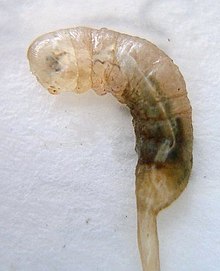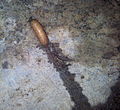Rat tail larva
Rat tail larvae are the larvae of certain species of hover flies that belong to the tribe Eristalini and Sericomyiini .
The most common rat tail larva is the dung bee larva ( Eristalis tenax ). This lives in stagnant, oxygen-poor water with a high content of organic matter. It is quite tolerant of pollution and can live in lagoons and septic tanks. In 2017, the rat tail larvae garnered media coverage after being found in the composting toilets at Glastonbury Festival.
Other rat tail larvae have:
features
A characteristic feature of rat tail larvae is a tubular, telescopically extendable breathing siphon located at its end. This acts like a snorkel, allowing the larva to breathe air while submerged. The siphon is usually about as long as the body of the maggot (20 mm at sexual maturity), but can be extended up to 150 mm. This organ gives the larva their common name. They can be distinguished from the larvae of the salt flies (Ephydridae), which also live in bodies of water and have a breathing tube: The breathing tube is longer, at least as long, often longer than the body of the larva itself; the last segment of the breathing tube is not bifurcated. In addition, the rat tail larva has greatly reduced mandibles .
Commercial use
These larvae, called "mousies" in English, are bred and sold as fishing bait. They are especially popular with ice fishing.
infection
Occasionally, cases of myiasis caused by the rat tail larva have been documented in the human intestine. Symptoms can range to stomach pain, nausea, and vomiting or itching without symptoms. Infection can be caused by ingestion of contaminated food or water, but doubts have been expressed as to whether accidentally ingested fly larvae can survive in the gastrointestinal tract. Fritz Konrad Ernst Zumpt suggested an alternative called "rectal myiasis". Flies attracted to their feces can lay their eggs or larvae near the anus or in the anus, and the larvae then continue to invade the rectum. You can survive the ingestion of food through feces at this point as long as the siphon extends towards the anus.
gallery
unidentified rat tail larva from Australia
unidentified rat tail larva from the Philippines
Individual evidence
- ↑ Alan E. Stubbs & Steven J. Falk: British Hoverflies: An Illustrated Identification Guide , 2nd. 1st edition, British Entomological and Natural History Society , London 1983, ISBN 1-899935-03-7 , pp. 284-300.
- ↑ a b c d A. Aguilera, A. Cid, BJ Regueiro, JM Prieto, M. Noya: Intestinal myiasis caused by Eristalis tenax . In: J. Clin. Microbiol. . 37, No. 9, September 1999, p. 3082. PMID 10475752 . PMC 85471 (free full text).
- ↑ Videotaped rat-tailed maggots crawling around the toilets at Glastonbury Festival Bristol Post, June 29, 2017
- ^ A. Sundermann, S. Lohse, LA Beck, P. Haase (2007): Key to the larval stages of aquatic true flies (Diptera), based on the operational taxa list for running waters in Germany. Annales de Limnologie - International Journal of Limnology 43 (1): 61-74.
- ↑ Dictionary of Ichthyology; Brian W. Coad and Don E. McAllister ( December 6, 2009 memento on the Internet Archive ) at www.briancoad.com
- ^ Whish-Wilson PB: A possible case of intestinal myiasis due to Eristalis tenax . In: Med. J. Aust. . 173, No. 11-12, 2000, p. 652. doi : 10.5694 / j.1326-5377.2000.tb139374.x . PMID 11379520 .




